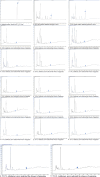Quality assessment of medicinal material Daqingye and Banlangen from Isatis tinctoria Fort. reveals widespread substitution with Strobilanthes species
- PMID: 40334225
- PMCID: PMC12058189
- DOI: 10.1371/journal.pone.0323084
Quality assessment of medicinal material Daqingye and Banlangen from Isatis tinctoria Fort. reveals widespread substitution with Strobilanthes species
Abstract
Background: Isatidis Folium (Daqingye, DQY) and Isatidis Radix (Banlangen, BLG) are the leaf and root of the plant Isatis tinctoria Fort. (syn. Isatis indigotica Fort.), commonly prescribed for detoxification, and the inhibition of viral and oxidative activities. Given their widespread use, we set forth to investigate the authenticity and chemical composition of DQY and BLG samples obtained from eighteen administrative districts in the Hong Kong market.
Methods: The present study screened the identities and chemical composition of DQY and BLG through molecular authentication and HPLC methods, respectively. Molecular authentication utilized DNA barcoding, focusing on nuclear ribosomal and chloroplast regions. The HPLC methods were conducted in accordance with the Hong Kong Chinese Materia Medica Standards (HKCMMS).
Results: We found that only one sample was genuine according to the species definition in the Chinese Pharmacopoeia and HKCMMS for both herbs. The chemical composition of the adulterated and the genuine samples were completely different, that the adulterant samples did not have the standard chemical markers epigoitrin and indirubin of Banlangen and Daqingye as listed in the Chinese Pharmacopoeia.
Conclusion: Our investigation underscores the widespread substitution by Strobilanthes (Nanbanlangen and Nandaqingye) species, mainly due to the preference of use of this herb in southern China. The adulteration of Daqingye by Blumea balsamifera (Ainaxiang) was probably due to mislabeling in the herb shop, though the error might have originated from the supplying sources. We recommend providing education on the necessity of using authentic Daqingye and Banlangen, especially in combined regimens, to standardize treatment effects. More education is also needed on the morphological differentiation of Banlangen from Nanbanlangen and Daqingye from Nandaqingye. The implementation of a track-and-trace system is strongly recommended to prevent and deter incorrect supply chain practices that lead to substitution or adulteration.
Copyright: © 2025 Ngai et al. This is an open access article distributed under the terms of the Creative Commons Attribution License, which permits unrestricted use, distribution, and reproduction in any medium, provided the original author and source are credited.
Conflict of interest statement
NO authors have competing interests
Figures
References
-
- Chinese Medicine Regulatory Office. Isatidis Folium. 2024. Available from: https://www.cmro.gov.hk/files/hkcmms/vol4/pdf_e/Isatidis_Folium_v4_e.pdf
-
- School of Chinese Medicine Medicinal Plant Images Database – Songlan. 2024. Available from: https://sys01.lib.hkbu.edu.hk/cmed/mpid/detail.php?herb_id=D00614
-
- Nadri GA. The making of the world market: indigo commodity chains. In: The Political Economy of Indigo in India, 1580-1930: A Global Perspective. Leiden: Brill; 2016. pp. 124–53.
-
- Campeol E, Angelini LG, Tozzi S, Bertolacci M. Seasonal variation of indigo precursors in Isatis tinctoria L. and Polygonum tinctorium Ait. as affected by water deficit. Environ Exp Bot. 2006;58(1–3):223–33. doi: 10.1016/j.envexpbot.2005.09.006 - DOI
-
- The Committee of Pharmacopeia of the People’s Republic of China. Pharmacopeia of the People’s Republic of China. 11th ed. Beijing: Chemical Industry Press; 2020.
MeSH terms
Substances
LinkOut - more resources
Full Text Sources
Miscellaneous



